This four-image NAVCAM montage comprises images taken on 15 October from a distance of 9.9 km from the centre of comet 67P/C-G – just ~7.9 km from the surface!
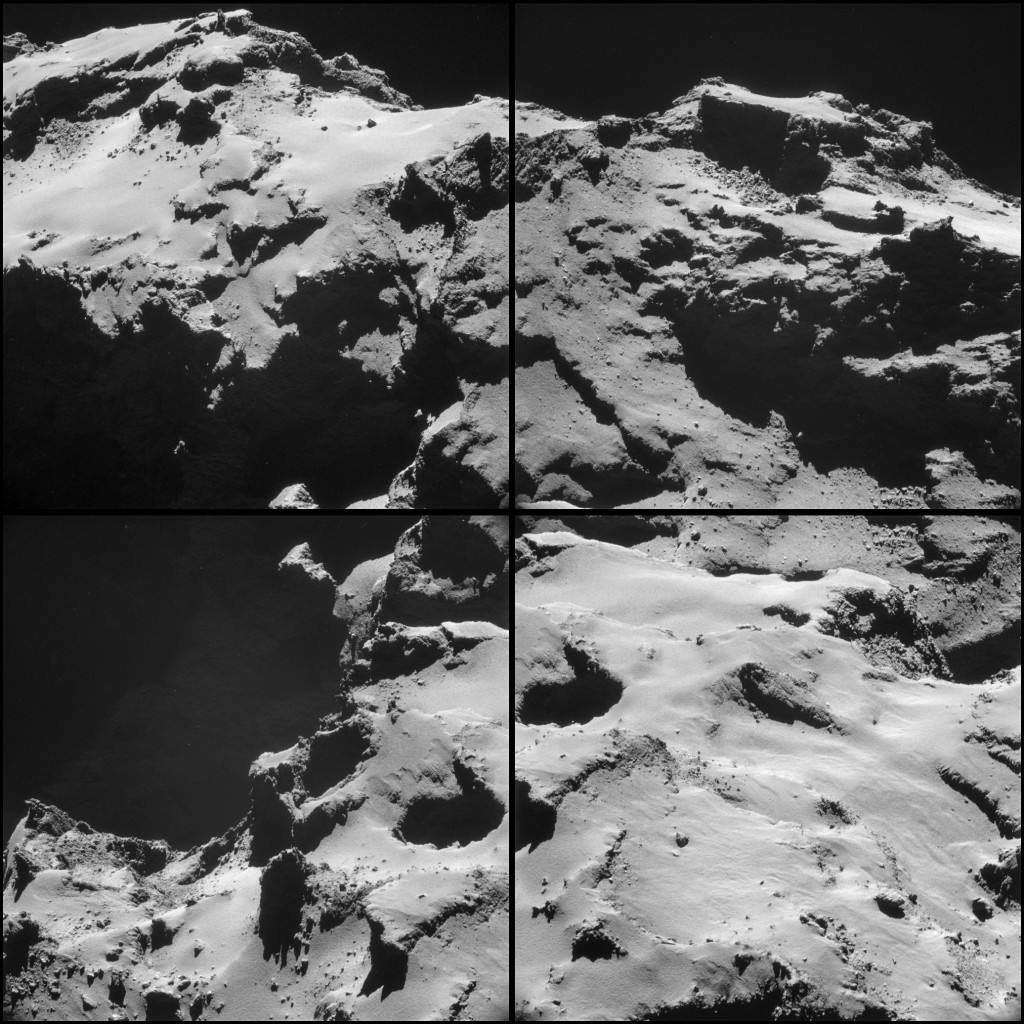
Comet 67P/C-G on 15 October, from a distance of 9.9 km from the centre of the comet.
Credits: ESA/Rosetta/NAVCAM
The orientation is such that we’re looking down onto the small lobe from above (bottom two frames), with the large lobe beyond (top two frames).
At this distance, the image scale is about 0.63 m/pixel, so each 1024 x 1024 pixel frame is about 650 metres across. Of course, at these close distances that’s only really valid for the nearside of the comet. With the furthest point being an additional ~1 km further from the centre, that reduces the image scale for the more distance frames to about 0.93m/pixel!
The four full-resolution individual images making up the montage are provided below.

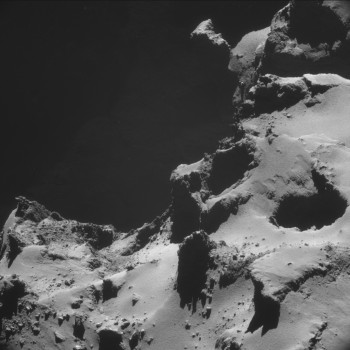
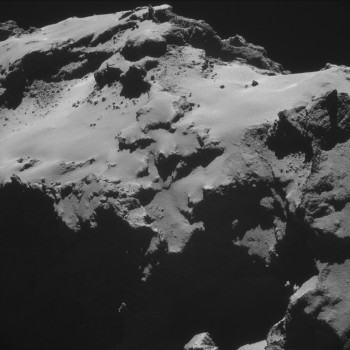
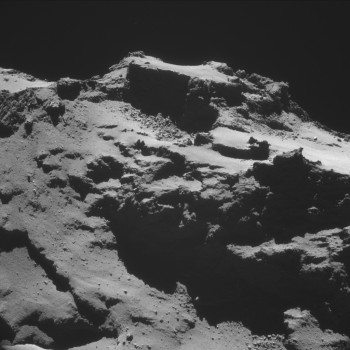
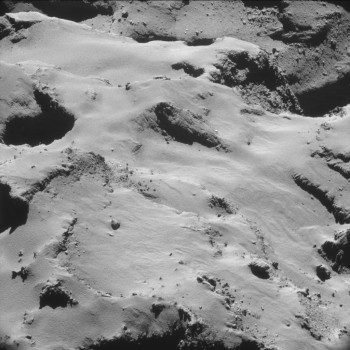








Discussion: 37 comments
Hallo!
Startete nich ein Wettbewerb um einen Namen für den Landeplatz des PHILAE-Landers? Ich würde ihn “Philae’s Den” nennen, “Philaes Heimstatt” also!
Also selbst dann wenn die Landung der Sonde völlig versemmet wird – die ROSETTA-Mission hat sich trotzdem voll gelohnt! Gratulation für die Qualitätsarbeit beim Bau von ROSETTA! Die Bilder sind DER HAMMER!
Noch eine Frage zum Kometen bzw. seiner Oberfläche: Ich habe den Eindruck, dass man hier Eiskanten sieht und es nur sehr feines unflüchtiges Material gibt, also Sand und Staub. Denn der Komet sieht fast aus als sein er “dick mit Zucker” bestreut. Wenn das so ist könnte PHILAE an solchen Stellen versinken! Weiß man schon Genaueres? Ich kann beim besten Willen nicht erkennen, was nun Eis und was evtl. Gestein ist. Auch sieht man beim jüngsten Foto eine Art “Plateau”, von dessen Wand eindeutig Material abgebröckelt ist.
Hoffentloch geht das gut ……. ;.)
Viele Nette Grüße vom Chemnitzer WOLF! 🙂
i’ve done a mozaic from these picture :
https://www.avex-asso.org/forum/viewtopic.php?f=42&t=4257&p=44012#p44012
And mosaic done here, on my blog (see at the bottom the last picture of the gallery) :
https://www.db-prods.net/blog/2014/10/14/rosetta-galerie-de-mosaiques-septembre-octobre-2014/
Draped over shapemodel. Flyover animation:
Mono: https://youtu.be/88zl_DYgcPg
Anaglyph version: https://youtu.be/ULuxPooziaM
3DTV version: https://youtu.be/Dtpv7ROvUOQ
Amazing pictures!
The closer they are taken from, the more obvious it becomes that the vast majority of the boulders are lying at (or very close to) the foot of the rocky cliffs we can see everywhere. They have clearly broken off the rock-faces and piled up at their base, just like we see them doing down here on Earth.
In accordance with this “rocks falling off cliff-faces principle”, the larger boulders are generally lying further away on those smooth plain-like surfaces, as is also natural given the greater momentum they developed during their fall due to their greater mass (as is the case with the Cheops rock also). Further out on the plains or wherever there are plains with no surrounding cliffs, there is, quite logically, nothing whatever, neither small nor large boulders.
There is thus neither room nor need for exotic accretion theories, or rocks- being-pushed-up-by-subliming-gases-from-inside-the-comet theories. It is now plain for everyone to see that the many thousands of boulders to be seen on 67P/C-G are just ordinary rocks which have fallen off ordinary cliff-faces, and not necessarily that long ago.
Such a beautiful body of rock and ice.
We can see the rock and rocks. Where’s the ice?
If you’re referring to those whitish-looking plains, it’s true we might imagine it’s a bit like a beautiful snowy Alpine landscape.
It’s just an illusion: what looks off-white is actually charcoal black. In the EU model, those plains are likely something like lava flows. I haven’t the faintest idea what they may be according to the standard model and I guess nobody else does either.
It looks like there is a very thick layer of dust on this bad boy.
😉
Some of us have ‘qualified’ it in surface ‘loose’ dust and sub-surface ‘compacted’ dust.
I fully agree with you Thomas, also in many cases you can see the track of the rock rolling across the dust.
In some places it looks like they have bounced slightly leaving small depressions along the track as they land (or maybe just deeper dust)
My take on this mosaic:
https://www.flickr.com/photos/105035663@N07/15377787780/
Danke für die schönen Bilder! Grazie!
Talking about rocks on Comet 67P/C-G (as I often do), I just found this extraordinary side-by-side comparison of two photographic images, visible in a “Thunderbolts” video published two days ago: https://www.thunderbolts.info/wp/2014/10/16/rosetta-could-change-science-forever-space-news/
The left-hand picture shows a strikingly jagged, up-thrusting lump of stratified rock on the skyline of Comet 67P/C-G and the right-hand one a photo of a strikingly similar rocky outcrop which is part of the Sawtooth mountain range in New Mexico. If you don’t want to see the start of the video, skip to minute 1:46. Then watch the whole thing….
There are nearly identical skyline features in several images from Rosetta, including this famous, totally rocky, OSIRIS image of 05/09/14: https://www.esa.int/spaceinimages/Images/2014/09/Comet_on_5_September_2014
It’s clearly a very common feature on 67P/C-G.
Just a coincidence?
After a little searching, I’ve just identified the precise feature on 67P/C-G shown in the Thunderbolts comparison. It’s in the upper left of the mosaic: https://blogs.esa.int/rosetta/2014/09/17/cometwatch-14-september/ .
There’s another very similar feature at the very top of the mosaic. I guess that from whatever angle the comet is imaged from, there always will be at least one example of the same sort of up-thrusting, jagged outcrop on the skyline.
I’ve found a picture of another, similar, huge rock formation in New Mexico, the “Shiprock”, complete with broken-off boulders at its feet, the larger ones further away from the base of the rock-face, just like on 67P/C-G ….
I think it’s all about pattern recognition.
Sorry, forgot to add in the “Shiprock” link: https://en.wikipedia.org/wiki/Rock_formations_in_the_United_States#mediaviewer/File:Shiprock.snodgrass3.jpg
What this comparison tells us is that the physical and chemical processes of Geology acting on crystalline solids lead to remarkably similar geological formations even though they are in two totally different environments. Nothing more. I find that very interesting in itself, but something that has been seen from Mercury to Triton throughout the solar system. So how does this prove that the formations and objects we see on 67P are made of the same crystalline solid as these mountains in New Mexico?
Sorry, Robin, but this sort of stratified formation with crumbled rock at its feet, sorted by size, has certainly not been seen “from Mercury to Triton”.
Whatever, I just don’t see what sort of “physical and chemical processes of Geology acting on crystalline solids” could have produced such “similar geological formations” on a dirty snowball.
If you wish to be deliberately obtuse and not answer the question posed, fair enough. I will draw my own conclusions from your failure to do so.
“Deliberately obtuse”? I thought better of you, Robin, from the high quality of your other posts, than what is suggested by this sort of huffy name-calling that other posters occasionally resort to…
As for your “question”, I didn’t need to answer it, because it’s a NON-question: I never spoke about PROOF of anything, only about striking similarities and pattern recognition. You can refuse to see them or deny either their existence or their significance, that’s your problem. But please don’t start calling people out because they haven’t answered a question which can obviously have no answer for the moment.
From there on out, you’re perfectly free to draw whatever conclusions you like, that’s your problem: it won’t make an iota of difference to the REAL proof we are all expecting to be ultimately disclosed by the mission scientists concerning the reality of this rocky, half-melted body.
Thanks for getting back Thomas. You have since stated that your comparison was not intended to be a “Proof” that the material on 67P is Rock. Simple I can accept that no bother. I hoped that’s what your answer would have been in the first place. I also agreed with you that the similarity of formations is interesting and tried to point out this was not unusual and the reasons why I thought so.
I did not say that “this sort of stratified formation with crumbled rock at its feet, sorted by size” has been seen from “Mercury to Triton”. My meaning was quite clear. The same geological processes at work across the solar system produce formations like we see on Earth. Volcanoes on Mars, Venus and Io. Geysers on Triton and Enceladus. River systems on Mars and Titan. The materials may be different, but the physical processes of erosion, moving liquids, geothermal activity and electrical activity in some cases, all produce similar looking results. I was trying not to say the material on 67P is “not rock”, by referring to it as a crystalline solid, as although lots of circumstantial evidence says it is probably volatile ices, no definitive data says it is. By deliberately trying not to antagonise those who might think 67P is made of Rock, I seem to have achieved the opposite. We have no other point of reference when imagining scenarios on an alien body and this forces the use of the terms “rock” and “Rock”. The confusion and misinterpretation is inevitable.
Robin, many thanks for your conciliatory response, which is much more in line with the image of the courteous person I had formed of you. We can differ without starting to call each other names.
My position continues to be extremely straightforward and in conformity with correct scientific method, which is based on OBSERVATION: when we see something that looks like stratified rock and even resembles the sort of stratified rock formations we have all seen here on Earth, the most logical conclusion is that it’s likely to be stratified rock. It’s what we call pattern recognition and it’s the stuff that scientific theories SHOULD be made of. And I honestly don’t see why we spent around a billion dollars sending Rosette to get these fabulous close-up pictures of this comet if the conclusion was always going to be that what looks like stratified rock is actually marshmallow. It so happens that the few images which have been released so far (“few” compared with the tens of thousands which could potentially have been released) hold absolutely no surprises for EU proponents because what we are seeing was actually PREDICTED by the EU people, whereas it has shocked the socks off supporters of the standard theory.
As for the sort of absolute, ultimate proof you seem to require, you know as well as I do that the jury is out and will presumably stay out for many more months or years, whatever the rock-solid proofs that Rosetta may provide.
If searching enough. I can find a rock with my face on it. But easier for me to ‘photo-shop’ it. Thomas, I get it, I feel the pain too. But we have to trust. A little.
It almost seemed impossible, but in the end, here is our mosaic:
https://flic.kr/p/prQQYm
As with previous times, images were handmade combined and merged.
(Colorized version: https://flic.kr/p/prNTYk)
You will have to add cryo-tectonics.
That would require a subsurface liquid for the plates to “float” on. I’m still trying to get a grip on things that look even more like Rock than they did two weeks ago, but are made of ice. Liquids at below 200 Kelvin with no internal heat source to maintain them, might be pushing it.
Hi Robin. Slowly ‘sliding’ by the idea that erosion is mainly sub-surface. This erosion cause ‘displacements’ on the surface ‘plates’. You are right, the term is not correct. But could not find a closer one 🙂
No problem Logan, it was a reasonable question to ask since volcanism is directly linked to plate tectonics on Earth. We know that such cryovolcanism on Europa and Enceladus are associated with liquid oceans and in Europa’s case there is some evidence of tectonic activity.
The original accretion process must have generated considerable heat and the core of the comet may have been a slushy liquid for some time before it cooled down and froze. Since we have no idea when all this surface activity occurred, cryo-tectonics may have played a role. Thats just a few to many ifs and maybes for me though.
I’m sticking with the impacters lodging deep inside the comet as the energy source for now. No doubt in a few days time I will dream up some other crazy scenario to suit what I think I see. I think it is usually called “making it up as you go along”. For me thats why its fun. Until we see clearly visible significant changes in the surface, its pretty hard to say how it all works. There are always several mechanisms acting at once.
Ceramic ‘worms’ extruding at bottom right border of
https://www.esa.int/var/esa/storage/images/esa_multimedia/images/2014/10/comet_on_15_october_navcam/14983131-1-eng-GB/Comet_on_15_October_NavCam.jpg
Pixel 1209,1779
Lots of ‘primordial’ material at Top center Wall.
By ‘primordial’ I mean not-sun-‘toasted’. Image the original accreted material very different from this ‘quasi-solid’. Some different symmetries encased in an apparently ‘cubic’ one.
https://www.esa.int/var/esa/storage/images/esa_multimedia/images/2014/10/comet_on_15_october_navcam/14983131-1-eng-GB/Comet_on_15_October_NavCam.jpg
Pixel 948,352
The layering of this material is so peaceful, so undisturbed. Deserves the ‘primordial’ name. Even if quite surely are Nth generation ‘rocks’.
And drawings, drawings all over the place. Even on sites crumbled down to dust. Drawings there.
My mind is about to crumble down to weird ‘field’ theories. Only ‘temporal’ scape is the admission that all of the surface is sublimating.
Line of dust ‘blastings’, probably temporary jets. Evident if you turn down brightness by half.
Location: Near Bottom Right of
https://www.esa.int/var/esa/storage/images/esa_multimedia/images/2014/10/comet_on_15_october_navcam/14983131-1-eng-GB/Comet_on_15_October_NavCam.jpg
From pixel 1743,600 to 1867,1656.
Wow, that reminds me of a moon light shot of some snow covered mountains I’ve climbed. Be easy to climb this, one jump and you’ld be on top…or in orbit ( :
Hi Rick. You have to ‘rept’ here, slowly.
Here’s our mosaic as part of my article about the naming contest.. certainly this one was more difficult to stitch:
https://www.americaspace.com/wp-content/uploads/2014/10/Rosetta-Comet-67P_141015_2A_Ken-Kremer.jpg
https://www.americaspace.com/?p=69509